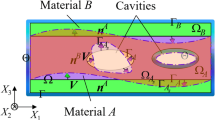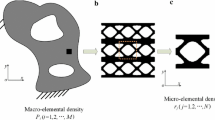Abstract
Apart from the lightweight and excellent mechanical properties, sandwich panels can be endowed with tailorable in-plane coefficient of thermal expansion (CTE) through an elaborate design of periodic face-sheets. However, albeit that the microstructural topology of their periodic face-sheets promises unique thermal expansion behaviors, it may also bring significant influences to the structural stiffness of sandwich panels. In this study, we apply the topology optimization method to design face-sheet microstructures to enable the sandwich panels to possess desired in-plane CTEs, lightweight and benign mechanical properties, simultaneously. By introducing the patch-based cell as initial configuration, the existing thermally bending adjustment mechanism for thermal deformation control is integrated to the process of topology optimization. The entire topology optimization process including the equivalent mechanical properties prediction and the sensitivity computation is performed within an in-house program coupled with commercial finite element analysis software. To this end, a matching numerical sensitivity analysis method to extract sensitivities straightforwardly from software’s output is also developed on the basis of asymptotic homogenization method. Three types of specific optimization problems in terms of different objective functions and constraint conditions are proposed, solved, and studied, namely, in-plane zero thermal expansion combining with maximum stiffness, the other for in-plane zero thermal expansion optimal specific stiffness, and minimizing in-plane isotropic thermal expansion. Some specific resulting topologies, microstructural features, and design details are subsequently obtained. In particular, the current strategy of integrating effective mechanism and topological technology can be extended to design more microstructures for simultaneously tailorable CTE and high mechanical performance by replacing present thermal deformation control mechanism with others.










Similar content being viewed by others
References
Ai L, Gao XL (2019) Topology optimization of 2-D mechanical metamaterials using a parametric level set method combined with a meshfree algorithm. Compos Struct 229:111318
Andreassen E, Lazarov BS, Sigmund O (2014) Design of manufacturable 3D extremal elastic microstructure. Mech Mater 69:1–10. https://doi.org/10.1016/j.mechmat.2013.09.018
Bendsoe MP, Kikuchi N (1988) Generating optimal topologies in structural design using a homogenization method. Comput Methods Appl Mech Eng 71:197–224
Bruns TE, Tortorelli DA (2001) Topology optimization of non-linear elastic structures and compliant mechanisms. Comp Methods Appl Mech Eng 190:3443–3459
Chen PC, Liu DD, Chang KT, Tang L, Wei S (2006) Aerothermodynamic optimization of hypersonic vehicle TPS design by POD/RSM-based approach. 44th AIAA Aerospace Sciences Meeting and Exhibit
Cheng GD, Cai YW, Xu L (2013) Novel implementation of homogenization method to predict effective properties of periodic materials. Acta Mech Sinica-Prc:550–556
Du Z, Zhu M, Wang Z, Yang J (2016) Design and application of composite platform with extreme low thermal deformation for satellite. Comput Struct 152:693–703
Kai W, Haosen C, Yongmao P, Daining F (2016) Planar lattices with tailorable coefficient of thermal expansion and high stiffness based on dual-material triangle unit. J Mech Phys Solids 86:173–191
Lakes R (2007) Cellular solids with tunable positive or negative thermal expansion of unbounded magnitude. Appl Phys Lett 90:359
Lehman J, Lakes R (2013) Stiff, strong zero thermal expansion lattices via the Poisson effect. J Mater Res 28:2499–2508
Ni X, Guo X, Li J, Huang Y, Zhang Y, Rogers JA (2019) 2D mechanical Metamaterials with widely tunable unusual modes of thermal expansion. Adv Mater 31:1905405
Sigmund O (1995) Tailoring materials with prescribed elastic properties. Mech Mater 20:351–368. https://doi.org/10.1016/0167-6636(94)00069-7
Sigmund O, Torquato S (1997) Design of materials with extreme thermal expansion using a three-phase topology optimization method. J Mech Phys Solids 45:1037–1067
Sigmund O, Torquato S (1999) Design of smart composite materials using topology optimization. Smart Mater Struct 8:365
Steeves CA, Evans AG (2011) Optimization of thermal protection systems utilizing sandwich structures with low coefficient of thermal expansion lattice hot faces. J Am Ceram Soc 94:s55–s61
Steeves CA, He M, Maxwell PT, Evans AG (2007a) Design of a Robust, multifunctional thermal protection system incorporating zero expansion LatticesASME 2007. Int Mech Eng Congr Exposit:2007255-260
Steeves CA, Lucato SLDS, He M, Antinucci E, Hutchinson JW, Evans AG (2007b) Concepts for structurally robust materials that combine low thermal expansion with high stiffness. J Mech Phys Solids 55:1803–1822
Svanberg K (1987) The method of moving asymptotes—a new method for structural optimization. Int J Numer Meth Eng 24:359–373. https://doi.org/10.1002/nme.1620240207
Takenaka K (2021) Negative thermal expansion materials: technological key for control of thermal expansion. Ence Technol of Adv Mat 13:13001
Takezawa A, Kobashi M, Kitamura M (2015) Porous composite with negative thermal expansion obtained by photopolymer additive manufacturing. Apl Mater 3:1477–1917
Torquato OSAS (1999) Design of smart composite materials using topology optimization. Smart Mater Struct
Torquato SAS (1997) Design of materials with extreme thermal expansion using a three-phase topology optimization method
Wang B, Yan J, Cheng G (2011) Optimal structure design with low thermal directional expansion and high stiffness. Eng Optimiz 43:581–595
Watts S, Tortorelli DA (2017) Optimality of thermal expansion bounds in three dimensions. Extreme Mech Lett 12:97–100
Wei K, Peng Y, Wang K, Duan S, Yang X, Wen W (2018) Three dimensional lightweight lattice structures with large positive, zero and negative thermal expansion. Compos Struct 188:287–296
Wei K, Chen H, Peng Y, Fang D (2016) Planar lattices with tailorable coefficient of thermal expansion and high stiffness based on dual-material triangle unit. J Mech Phys Solids 86:173–191
Wu L, Li B, Zhou J (2016) Isotropic negative thermal expansion Metamaterials. Appl Mater Interfaces 8:17721–17727
Xia L, Breitkopf P (2015) Design of materials using topology optimization and energy-based homogenization approach in Matlab. Struct Multidiscip Optim 52:1229–1241
Xie Y, Lu D, Yu J (2017) Bimaterial micro-structured annulus with zero thermal expansion coefficient. In: Asme International Design & Engineering Technical Conferences & computers & information in engineering conference
Xie Y, Pei X, Yu J (2018a) Double-layer sandwich annulus with ultra-low thermal expansion. Compos Struct 203:709–717. https://doi.org/10.1016/j.compstruct.2018.07.075
Xie Y, Pei X, Yu J (2018b) Double-layer sandwich annulus with ultra-low thermal expansion. Compos Struct 203:709–717. https://doi.org/10.1016/j.compstruct.2018.07.075
Xu H, Farag A, Pasini D (2017) Multilevel hierarchy in bi-material lattices with high specific stiffness and unbounded thermal expansion. Acta Mater 134:155–166. https://doi.org/10.1016/j.actamat.2017.05.059
Xu H, Pasini D (2016) Structurally efficient three-dimensional Metamaterials with controllable thermal expansion. Sci Rep-Uk 6:34924
Yamamoto N, Gdoutos E, Toda R, White V, Manohara H, Daraio C (2014) Thin films with ultra-low thermal expansion. Adv Mater 26:3076–3080
Yang Z, Zhang Y, Liu S, Wu Z (2019) Design and analysis of dual-constituent lattice sandwich panel with in-plane zero thermal expansion and high structural stiffness. Mech Adv Mater Struct:1–12
Yi S, Cheng G, Xu L (2016) Stiffness design of heterogeneous periodic beam by topology optimization with integration of commercial software. Comput Struct 172:71–80
Zhang H, Luo Y, Kang Z (2018a) Bi-material microstructural design of chiral auxetic metamaterials using topology optimization. Compos Struct:S342817304
Zhang Y, Liang Y, Liu S, Wang B (2018b) A new design for enhanced stiffness of dual-constituent triangular lattice metamaterial with unbounded thermal expansion. Mater Res Express 6:015705
Zhang Y, Liang Y, Yang Z, Wang B, Liu S (2019a) A new design concept of dual-constituent sandwich panel with in-plane zero thermal expansion. Smart Mater Struct 28:65002
Zhang YC, Liang YJ, Liu ST, Su YD (2019b) A new design of dual-constituent triangular lattice metamaterial with unbounded thermal expansion
Zhang Y, Shang S, Liu S (2017) A novel implementation algorithm of asymptotic homogenization for predicting the effective coefficient of thermal expansion of periodic composite materials. Acta Mech Sinica-Prc 33:368–381
Zhu H, Fan T, Peng Q, Zhang D (2018) Giant thermal expansion in 2D and 3D cellular materials. Adv Mater 30:e1705048
Acknowledgements
The work is supported by National Nature Science Foundation of China (Grant no. 11972105, U1808215). We would also like to thank the Fundamental Research Funds for the Central Universities.
Author information
Authors and Affiliations
Corresponding author
Ethics declarations
Conflict of interest
The authors declare that they have no conflict of interest.
Replication of results
The results presented in this work are based on the flowchart shown in Fig. 4. In order to replicate the results, a series of Matlab code is provided as supplementary material. The attached main program is named as “MATDesign_CTE.m” and other function programs are utilized to compute equivalent mechanical properties and the necessary sensitivity information in case 5.1. For replication of the results of other cases in the proposed work, the resulting designs can be obtained through modifying objective functions and constrain conditions to those in Eqs. (7) and (8).
Additional information
Responsible Editor: Ji-Hong Zhu
Publisher's note
Springer Nature remains neutral with regard to jurisdictional claims in published maps and institutional affiliations.
Electronic supplementary material
Appendices
Appendix 1: Implementation steps of NSAM-CTE
Similar with the implementation mode of NIAH-CTE for predicting the effective CTEs of periodic microstructures, the present NSAM-CTE can be implemented using the simulation capacity of commercial FEA soft as a black box. The sensitivity information in the form of element strain energy can be extracted directly from the output of FEA software, which substantially reduces the computational cost compared with that of using traditional methods. The concrete implementation steps of NIAH-CTE for predicting the sensitivities of the effective CTE \( \partial {\boldsymbol{\alpha}}_i^{\boldsymbol{H}}/\partial {\rho}_e \) are given as follows:
-
Step 1:
Build the finite element model for cell microstructure using standard modeling process.
-
Step 2:
Predict the effective elastic modulus EH and thermos-elastic constant βH of cell microstructure using numerical results given by NIAH-CTE.
-
Step 3:
Apply the generalized strain fields \( {\overline{\boldsymbol{\varepsilon}}}^{\boldsymbol{i}+\alpha } \) to the finite element model for element strain energy \( {WB}_e^{i+\alpha } \). Note that the element strain energy caused by the specific strain fields can be obtained through applying equivalent nodal displacement fields on each node due to the essence of the NIAH method. We can just construct the nodal displacement fields \( {\chi}^{\boldsymbol{0}\left(\boldsymbol{i}\right)}-{\chi}^{\ast \left(\boldsymbol{i}\right)}-{\chi}^{\zeta } \) and thermal loads (−1 °C) for \( {\overline{\boldsymbol{\varepsilon}}}^{\boldsymbol{i}+\alpha } \), and as input to the finite element model, the element strain energy \( {WB}_e^{i+\alpha } \) can be extracted directly from the output of FEA software after one static analysis. The extractions for the element strain energies \( {W}_e^{ii} \) and \( {WB}_e^{\alpha } \) are subsequently performed using the same implementation procedure.
-
Step 4:
Calculate the sensitivities of the effective thermos-elastic constant ∂βH/∂ρe from Eq.(17)–(23).
-
Step 5:
Extract the sensitivities of the effective elastic modulus \( \partial {\boldsymbol{E}}_{ij}^{\boldsymbol{H}}/\partial {\rho}_e \) from the output of FEA software using original numerical sensitivity analysis method (Yi et al. 2016). For the purpose of the brevity, the concrete implementation steps for obtaining \( \partial {\boldsymbol{E}}_{ij}^{\boldsymbol{H}}/\partial {\rho}_e \) are not presented herein.
-
Step 6:
Calculate the sensitivities of the effective CTE \( \partial {\boldsymbol{\alpha}}_i^{\boldsymbol{H}}/\partial {\rho}_e \) from Eq. (16).
Appendix 2: Method verification of NSAM-CTE
In order to verify the effectiveness of present NSAM-CTE for computing the sensitivities, a simple verification example is performed through comparing the sensitivity results with that obtained by the finite difference method (FDM). After establishing the finite element model of original design configuration as shown in Fig. 3 (a), three arbitrary elements are taken as the testing cases for verifications. The comparison results of \( \partial {\boldsymbol{E}}_{ij}^{\boldsymbol{H}}/\partial {\rho}_e \) and \( \partial {\boldsymbol{\alpha}}_i^{\boldsymbol{H}}/\partial {\rho}_e \) given by NSAM-CTE and FDM are listed in Table 5 and Table 6, respectively. The finite-difference interval Δρfor FDM is taken as 1 × 10−4.
It can be seen from Table 5 and Table 6 that the sensitivity results of main in-plane coefficients of effective elastic modulus and CTEs match very well with the results computed using FDM. As such the effectiveness of the present numerical sensitivity analysis method and corresponding implementation steps are verified.
Rights and permissions
About this article
Cite this article
Yang, Z., Zhang, Y., Liu, S. et al. Microstructural topology optimization for patch-based sandwich panel with desired in-plane thermal expansion and structural stiffness. Struct Multidisc Optim 64, 779–795 (2021). https://doi.org/10.1007/s00158-021-02889-0
Received:
Revised:
Accepted:
Published:
Issue Date:
DOI: https://doi.org/10.1007/s00158-021-02889-0




